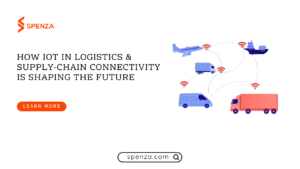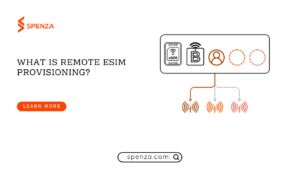Telecom expense management (TEM) helps enterprises track telecom inventories, audit invoices, and reduce wireless/data costs—using proven processes, tools, and KPIs. In this guide, we unpack how TEM works in practice, the core components, and how a modern TEM solution can cut telecom costs more cost effectively across your organization.
Table of Contents
- Introduction to Telecom Expense Management
- TEM Definition and Terminology
- Relationship with Enterprise Mobility Policy
- Why TEM Matters: The Necessity of Managing Telecom Expenses
- Telecom Spend as a Percentage of IT Budget
- Hidden Management Costs
- The Shifting Dynamic to Mobility
- From Fixed Line to Mobile Services
- Impact of 5G and Future Technologies
- Benefits of Implementing TEM
- Visibility: Alerts, Reporting, and Analytics
- Optimization and Future Proofing
- Audit Kick Start
- Cost Savings and Budget Management
- Enterprise Mobility Policy
- Industries Use Cases for TEM
- Finance
- Healthcare
- IT Procurement
- Manufacturing
- Network Services
- Retail
- Technology
- Implementing TEM in Your Business
- Step 1: Assess Current Telecom Expenses & Pain Points
- Step 2: Choose the Right TEM Software or Partner
- Step 3: Automate Invoice & Contract Management
- Step 4: Optimize Telecom Usage with AI & Analytics
- Step 5: Regularly Audit & Adjust TEM Strategies
- Future Trends in Telecom Expense Management
- AI & Machine Learning in TEM for Predictive Cost Control
- Cloud-Based TEM Solutions for Remote Work Environments
- Integration with 5G, IoT, and Unified Communications
- The Spenza Advantage
- Overview of the Spenza TEM Solution
- Key Features and Benefits
- Conclusion
- FAQs
Introduction to Telecom Expense Management
Most organizations—SMB to global enterprise—depend on telecom services (voice, data, UCaaS, mobility). The way you procure, allocate, and govern these services directly influences spend, user experience, and compliance. Telecom expense management (TEM) brings discipline to that lifecycle—inventory management, invoice processing, invoices auditing, contract management, and analytics—so teams can find cost savings opportunities and reduce costs without slowing the business.
What Is Telecom Expense Management (TEM)?
Definition. TEM is the coordinated set of management solutions, processes, and services that control the costs and assets tied to telecom services (wireline, wireless, data, UC&C). Typical outcomes include identifying billing errors, optimizing rate plans, managing telecom assets, and improving visibility for Finance, IT, and Procurement.
Common terms you’ll see:
- WEM (Wireless Expense Management): mobility-specific TEM (devices, plans, roaming, stipends).
- Technology/IT Expense Management: when scope expands to cloud/SaaS and network resources.
Key Components of TEM (What Good Looks Like)
- Inventory Management: Real-time, normalized inventory of telecom services and telecom assets (numbers, SIMs, devices, circuits, features). Tie each item to an owner, location, contract, and cost center.
- Invoice Processing & Invoices Auditing: Electronic intake, charge normalization, contract/rate validation, tax/fee checks, and dispute management—on every cycle—for carrier, MSP, and UCaaS invoices. Automated controls accelerate approvals and support Finance audits by identifying billing errors early.
- Contract Management: Central repository of MSA/SLAs, terms, and expirations with milestone alerts to prevent auto-renewals; price-book governance to enforce negotiated rates with suppliers and strengthen vendor relationships.
- Analytics & Optimization Services: Benchmarks, anomaly detection, usage trend analysis, and recommendation engines that cost optimize plans, roaming, and features—driving measurable reducing costs month after month.
- Ordering & MACD: Govern Moves, Adds, Changes, Deletes with policy checks and workflow—keeping inventory and chargeback accuracy intact.
Benefits of Implementing TEM
- Visibility & Control: One system of record for telecom assets, contracts, rates, and usage; role-based dashboards that roll up by geography, department, and cost centers.
- Cost Optimization: Analytics surface cost savings opportunities (unused lines, wrong plans, orphaned services) and continuously cost optimize rate plans and features.
- Accuracy & Compliance: Automated validations help with identifying billing errors on every telecom invoice; policy guardrails reduce leakage and overspend.
- Process Efficiency: Standardized workflows for invoice processing, approvals, disputes, and contract management reduce cycle times and late fees.
- Future-proofing: Data-driven optimization services and recommendations as usage shifts to 5G, IoT, and UCaaS.
Best Practices for TEM Implementation
- Conduct a Comprehensive Audit: Begin with a detailed audit of current telecom expenses to identify discrepancies and areas for improvement.
- Leverage Automation: Invest in TEM tools that offer automated invoice processing and real-time reporting.
- Engage Stakeholders: Collaborate with finance, IT, and procurement teams to align TEM initiatives with overall business objectives.
- Establish Clear Metrics: Define key performance indicators (KPIs) to continuously monitor savings, efficiency, and compliance.
- Regularly Update Contracts: Maintain and review vendor contracts periodically to ensure competitive pricing and optimal service levels.
TEM Relationship with Enterprise Mobility Policy
Your mobility policy sets rules for devices, security, usage, and reimbursements (including BYOD). Studies show mobility strategy and programmatic controls materially impact cost and productivity—TEM operationalizes those controls at scale with auditable processes and data.
You may also find people referring to this area using terms such as TEM telecom, telephone or telecommunications expense management, enterprise telecom management, and of course components such as telecom expense management system or software, telecom expense reporting, and so on. These are the same areas of focus so don’t get confused when you hear such terms.
Why TEM Matters
Communications services remain one of the largest IT spending categories globally, so even small percentage improvements translate into material dollars. TEM brings structure to messy, multi-carrier environments where services, users, and contracts constantly change.
Key pain points TEM addresses:
- Fragmented vendor relationships and complex contract management
- Incomplete inventory management across users, locations, and circuits
- Manual invoice processing and weak invoices auditing, which miss billing errors
- Limited allocation of expenses to the right cost centers
- Underused services and plans that are not cost optimized
According to Gartner communications-related spend represents around 25% of total IT expenses (global view).
| Category | 2024 Spending | 2024 Growth (%) | 2025 Spending | 2025 Growth (%) |
|---|---|---|---|---|
| Data Center Systems | 329,132 | 39.4 | 405,505 | 23.2 |
| Devices | 734,162 | 6.0 | 810,234 | 10.4 |
| Software | 1,091,569 | 12.0 | 1,246,842 | 14.2 |
| IT Services | 1,588,121 | 5.6 | 1,731,467 | 9.0 |
| Communications Services | 1,371,787 | 2.3 | 1,423,746 | 3.8 |
| Overall IT | 5,114,771 | 7.7 | 5,617,795 | 9.8 |
Forrester Research suggests that 7.6% of total IT spend is on mobile/cellular/wireless connectivity services. These are big numbers and so need to be carefully considered.
The direct cost is one thing, but you also need to consider the efficiency in managing the mobility policy and TEM practices; overheads that are often invisible. The July 2022 Oxford Economics survey report ‘Maximizing Mobile Value – To BYOD or not to BYOD?’ suggests that management overheads can be as much as 75% over and above connectivity costs. So, for every $100 spent on your mobile service provider, you could incur $75 more hidden costs on management and administration.

Source: June 2018 Oxford Economics survey report ‘Maximizing Mobile Value: Is BYOD holding you back?’
If you don’t know how much time and resource is spent on your TEM and mobility policy management, it’s worth an exercise to assess – the results may surprise you. Also, check out this article on TEM services (outsourcing your TEM and enterprise mobility policy) that can help to simplify and improve TEM outcomes whilst reducing costs.
The shifting dynamic to mobility
In the not-so-distant past, TEM was quite a mixed bag of communications products and services. And it still is for some businesses. But in recent years, and with a major emphasis during the COVID-19 pandemic, products, and services that enable mobility are now more prevalent. Significant movements from fixed line to mobile service connections are seen across the board in multi-play communications service providers.
The signs are that this trend will continue, especially as 5G (and not-so-far-away 6G) networks gain traction. With increasing mobile data speeds and bandwidth comes numerous fixed PBX alternatives; fixed line telecom services might soon become more of a niche backup/redundancy option as the workforce and customers are increasingly engulfed in the mobile trend. Accordingly, we envisage TEM increasingly focused on mobile services and associated elements.
Benefits of Telecom Expense Management Software
What Does TEM Mean in Practice? Telecom Expense Management (TEM) goes beyond cost control, although that remains a core component. In practice, TEM encompasses the entire lifecycle of managing telecom products and services within your organization. This includes everything from procurement and payment to ongoing maintenance and optimization.
TEM also integrates a critical concept known as MACD—Move, Add, Change, and Delete. These actions ensure that telecom assets and services are continually aligned with your business needs. For instance:
- Moves: Relocating telecom services for employees or locations.
- Adds: Provisioning new devices or services for growth or expansion.
- Changes: Addressing service modifications to adapt to evolving requirements.
- Deletes: Removing redundant or unnecessary services to minimize wastage.
Ultimately, TEM is an all-encompassing strategy that ensures telecom resources are optimized, aligned with corporate goals, and effectively managed across the entire organization. TEM also often includes expense management software to improve the efficiency and effectiveness of what is otherwise a rather complex and manual activity. TEM can focus solely on the services piece, or also include related hardware/devices and other IT/software components.

Visibility: Alerts, Reporting, and Analytics
Data is king! With access to the underlying telecom inventory, data, and spend/bills, the ability to visualise expenses by business unit, geography, department, and employee is enabled. Of course, telecom expense reporting can be done on spreadsheets but having a platform to do it for you automatically and present the right dashboard and drill-down views works wonders. It puts you in control of the costs. Overcharges and billing errors are quickly identified with TEM and cases would be evidenced for recovery from the service provider.
With near-real-time access to the data, you can also become proactive in addressing issues with users and teams where overspend, unauthorised activity (e.g. roaming) or fraud (e.g. PBX hacks or service resale) is spotted. Unused services or devices are quite a common problem in business, for example departing employees – it’s hard to keep track of the change volume without a specialist TEM process or system. TEM services can really help to proactively identify unused services and stop the billing for these immediately.
Apart from standard reporting, automated alert features are great for the rapid detection of issues. These alerts are usually configured within the TEM software or platforms you employ and can be at any level: country, department, team, user, etc. Early notification of high usage for example can ensure rapid control and significant cost savings.
Optimization and Future Proofing
With TEM in place, you can let the experts take the lead in optimizing your telecom spend and related policy. Whether it’s an in-house team or an outsourced partner, they should know what they’re doing. With experts looking at the data and managing the procure-to-pay process you can generally be sure of great improvements to what you buy, the nature of the contract, how it is used, and how it is managed. Oh yes, and how much it cost you…the data will usually show where costs can be trimmed and enable informed procurement and negotiation positions with your service or hardware providers.
Payments can be administered automatically with built-in audit and control points to satisfy even the strictest Finance and Audit teams. And reducing the need for bill and payment reconciliation frees up time from your Finance Operations function. Everyone wins.
Where TEM solutions are used, these typically take the brunt of interfacing to your core systems. It’s often way less distracting to engage the partner to update the interfaces when your core systems change than doing it yourself. And of course, many vendors add and curate standard APIs to their integration stack for off-the-shelf use in many popular business technologies.
With the continuous improvement of your TEM in place, onboarding new resources into your mobility policy becomes increasingly straightforward. Policy and process continue to improve. Efficiency and effectiveness reign.
Audit Kick Start
TEM enables inventory management of your telecom assets, for example, SIM cards and devices. If you decide to utilise a TEM software or services partner, then the move to that approach will also facilitate a deep dive into your current setup – most solution and services providers would start with a detailed audit of your current model. With that audit, you really get a great picture of the opportunity for change – a real kick-start to the continuous improvement journey that TEM enables. For example, are your mobile services procured with the right quality-cost balance, or are there immediate wins to take advantage of? The audit is a great way to take stock of your position and make a change for the good.
Cost Savings and Budget Management
Budget management has a strong element of cost focus and so a TEM approach that keeps both Finance teams and budget holders happy is ideal. Real-time or monthly reporting clearly adds a lot of value to cost and budget management, but you can also use the data to project costs and better estimate budgets. Good TEM solutions include such features and enable informed negotiations with your service providers for fundamental contract and cost changes.
Combining with the department views and alerts above, your TEM approach can really make a significant cost difference to your business and improve future budgeting confidence, meaning funds can be allocated to core business instead of over-allocated to telecom expenses.
Enterprise / Global Mobility Policy
Nothing has shown the need for an enterprise mobility policy like the COVID-19 pandemic. If you didn’t have one before, you probably do now, albeit possibly in a condensed and hurried form. No matter the format, the purpose is to provide a common approach to the workforce in mobile working. Setting standards, defining operational parameters, and making rules for use and abuse that need to be followed. See our template enterprise mobility policy here.
Industries Use Cases for TEM
Different industries face unique challenges when it comes to managing their telecom expenses. Let’s explore how TEM solutions address specific needs across various sectors:
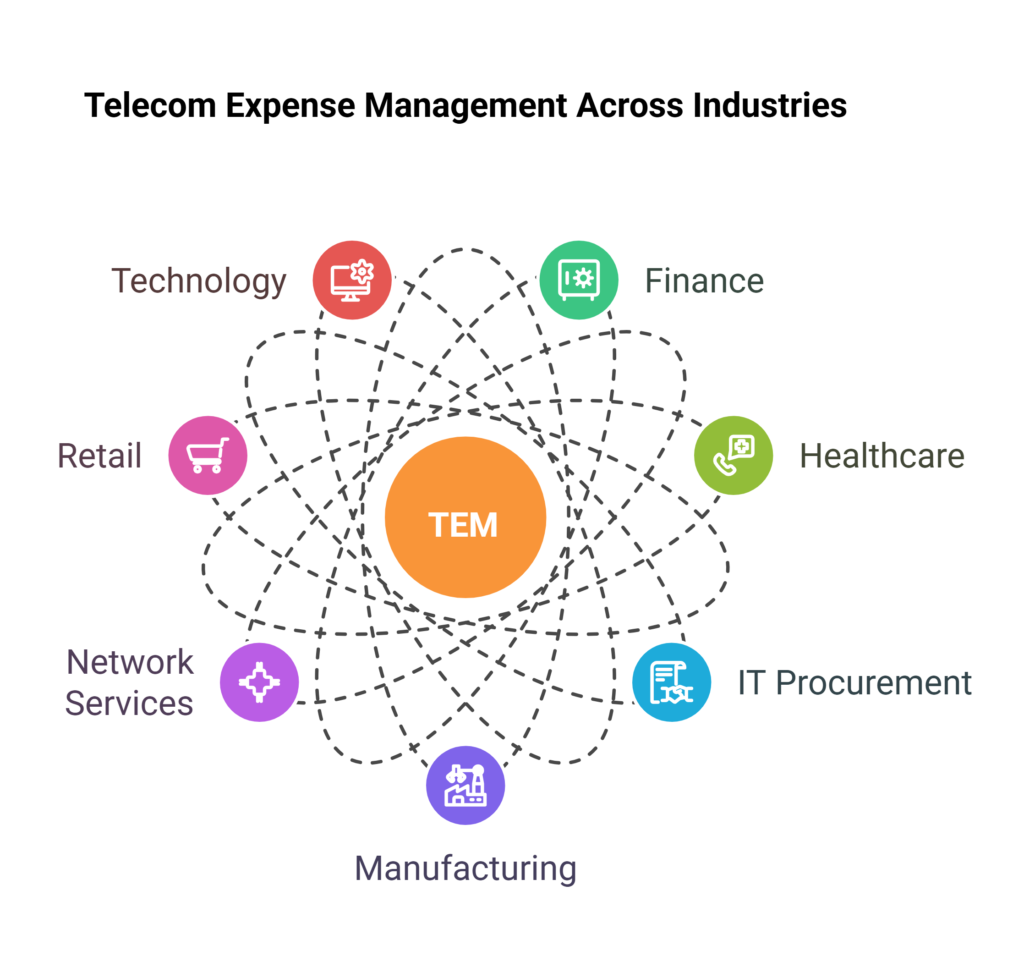
1. Finance
Security and following the rules are very important in the finance field. Telecom Expense Management (TEM) helps banks by making telecom costs easier to see and manage. This makes sure that communication is safe and that strict rules are followed. Many phone lines and devices are managed by banks. TEM helps them find services that aren’t being used, make the best use of their plans, and follow laws like SOX and GLBA, which saves them millions of dollars every year.
Finance professionals rely on TEM for:
- Automating invoice processing and payment
- Allocating costs to appropriate cost centers
- Forecasting telecom expenses with greater accuracy
- Identifying billing errors and recovering overpayments
- Providing detailed cost analysis for financial reporting
2. Healthcare
By lowering telecom costs, healthcare providers can reach patients at scale. This improves patient outcomes and operating efficiency while protecting the privacy of patient data. As telehealth services grow, TEM solutions help businesses stay in line with HIPAA rules and handle mobile health and remote patient tracking, even though the cost of telecom is going up.
Healthcare professionals depend on TEM for:
- Lowering expenses by identifying unused telecom services
- Sticking to HIPAA regulations to protect patient data
- Simplifying communication for seamless healthcare coordination
- Managing the growth of telehealth and remote monitoring systems
3. IT Procurement
The IT procurement department leverages TEM to negotiate better contracts and manage vendor relationships effectively. TEM tools provide the data and insights to make informed decisions, ensuring the organization gets the best value from its telecom investments.
With comprehensive inventory visibility and usage analytics, procurement teams can:
- Identify opportunities for contract consolidation
- Negotiate from a position of knowledge
- Prevent auto-renewals of unfavourable terms
- Benchmark pricing against industry standards
- Track service level agreements compliance
4. Manufacturing
In manufacturing, TEM combines telecom services with production, supply chain, and logistics. Manufacturers improve real-time communication, prevent downtime, and maximize costs by controlling telecom expenses.
Manufacturers depend on TEM for:
- Optimizing telecom expenses across operations
- Improving real-time communication and productivity
- Reducing downtime with stable telecom services
5. Network Services
For network services, TEM ensures the reliability and efficiency of telecom infrastructures. By analyzing inventory, monitoring usage and performance, network services departments can easily address issues, optimize network configurations, and reduce downtime.
Network teams utilize TEM to:
- Maintain accurate inventories of all network assets
- Track service performance metrics
- Plan capacity expansions based on actual usage patterns
- Identify redundant or obsolete services
- Support network modernization initiatives
6. Retail
In retail, TEM manages connectivity between stores, online platforms, and supply chains. Efficient telecom expense management enhances customer experience, drives sales, and controls overhead costs. Multi-location retailers benefit from centralized management of POS systems, inventory tracking, and customer service communications.
Retailers depend on TEM for:
- Centralizing management of POS and inventory systems
- Ensuring consistent telecom services across stores
7. Technology
In the technology sector, TEM manages extensive telecommunications for development, operations, and customer support. It enables agile and cost-effective communication networks, crucial for collaboration and delivering innovative products.
Tech companies depend on TEM for:
- Adapting quickly to changing telecom needs
- Managing expenses for agile networks
- Supporting effective team communication
- Enabling delivery of cutting-edge products
Implementing TEM in Your Business
Implementing a TEM solution requires careful planning and execution. Here’s a step-by-step approach to ensure successful TEM implementation:
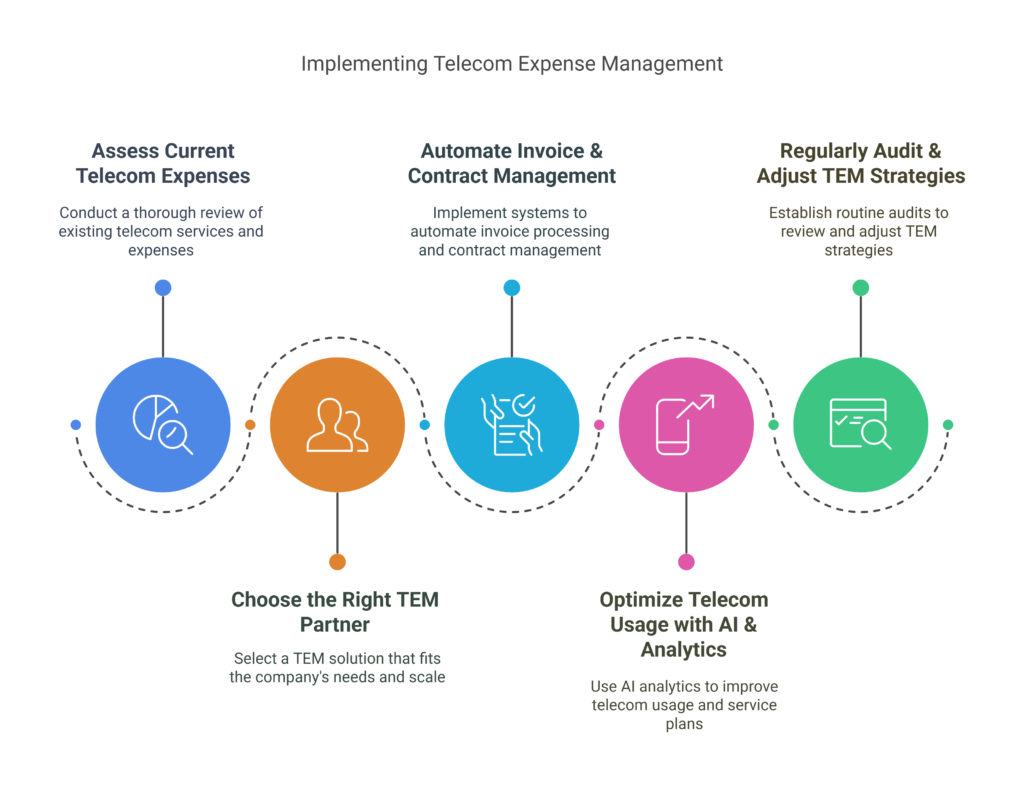
Step 1: Assess Current Telecom Expenses & Pain Points
Start with a full review of your existing telecom setup. This means making a list of all your services, equipment, agreements, and related expenses. Figure out what’s not working well in your current management approach, like billing errors, contracts that aren’t efficient, or lack of visibility.
A thorough assessment should include:
- Complete inventory of all telecom services and assets
- Analysis of historical spending patterns
- Identification of immediate cost-saving opportunities
- Documentation of current processes and responsibilities
Step 2: Choose the Right TEM Partner
Select a TEM solution that fits your company’s scale, complexity, and unique requirements. Think about things like how well it connects with other tools, what kind of reports it can generate, ways it can automate tasks, and how much the vendor knows about your domain.
When evaluating TEM providers, look for:
- Industry-specific experience and references
- Compatibility with existing systems and processes
- Scalability to accommodate future growth
- User-friendly interfaces and reporting capabilities
- Strong customer support and implementation assistance
Step 3: Automate Invoice & Contract Management
Implement automated systems to process invoices, check charges, and handle contracts. This will reduce manual work, reduce mistakes, and ensure on-time payments. It also gives you a clearer picture of how money is being spent.
Effective automation includes:
- Electronic invoice processing with validation against contracts
- Automated allocation of expenses to appropriate cost centres
- Contract milestone alerts to prevent auto-renewals
- Dispute management workflows
- Historical tracking for audit purposes
Step 4: Optimize Telecom Usage with AI & Analytics
Use AI-powered analytics to spot trends, unusual patterns, and ways to improve your telecom usage. These findings help you make informed choices about service plans, adjusting capacity, and investing in technology.
Advanced analytics capabilities enable:
- Usage pattern identification across the organization
- Anomaly detection for potential fraud or misuse
- Predictive analytics for capacity planning
- Rate plan optimization based on actual usage
- ROI analysis of telecom investments
Step 5: Regularly Audit & Adjust TEM Strategies
Establish a routine to review your TEM program’s effectiveness. Regular audits help identify new opportunities for optimization, ensure compliance with policies, and adapt to changing business needs.
A sustainable TEM program includes:
- Quarterly review of key performance metrics
- Annual comprehensive telecom audits
- Continuous optimization of processes and systems
- Regular training for staff on TEM best practices
- Executive reporting on cost savings and efficiency gains
Future Trends in Telecom Expense Management
As technology evolves, so does the landscape of telecom expense management. Here are key trends shaping the future of TEM:
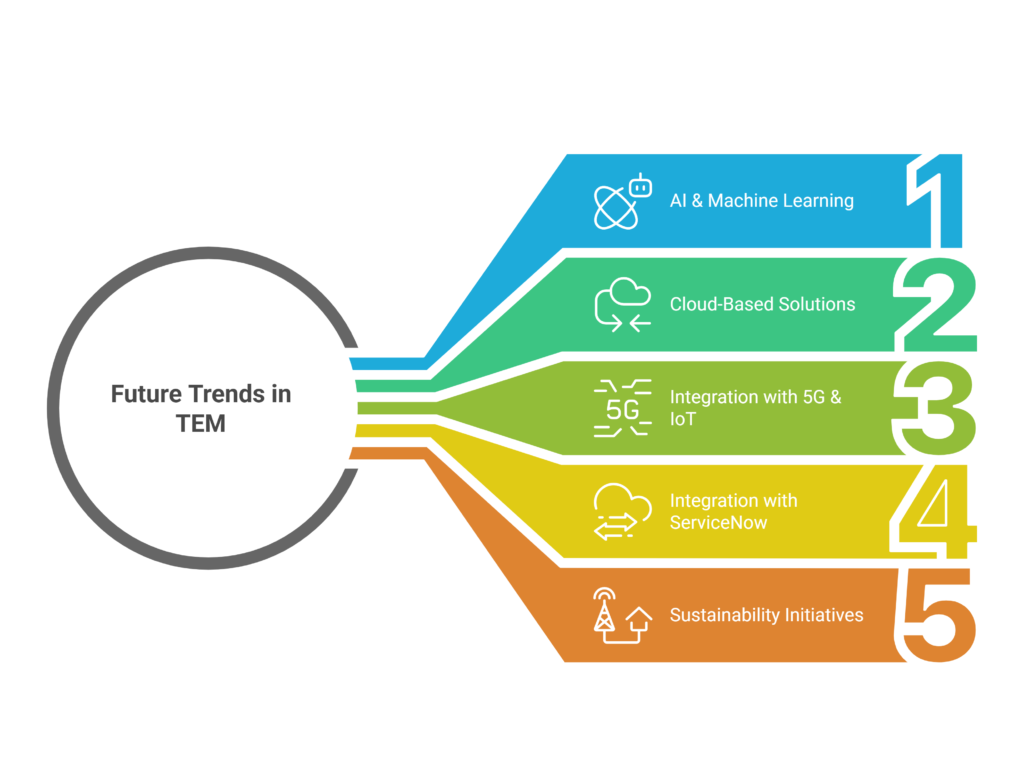
1. AI & Machine Learning in TEM for Predictive Cost Control
AI and ML are revolutionizing TEM by enabling predictive analytics, automated optimization, and intelligent anomaly detection. These technologies help organizations predict future telecom needs and proactively optimize costs.
2. Cloud-Based TEM Solutions for Remote Work Environments
The shift to remote and hybrid work models has accelerated the adoption of cloud-based TEM solutions. These platforms provide flexible access to telecom expense data and management tools from anywhere, supporting distributed workforce management.
3. Integration with 5G, IoT, and Unified Communications
As organizations adopt 5G networks, expand IoT deployments, and implement unified communications platforms, TEM solutions are evolving to manage these complex environments. Next-generation TEM incorporates capabilities to optimize expenses across these emerging technologies.
4. Integration of TEM and ServiceNow
Thousands of organizations are adopting ServiceNow to digitize workplace workflows. These companies are looking to integrate TEM with ServiceNow for improved inventory management, order management, invoice approvals, and network optimization.
5. Sustainability and Environmental Initiatives
Sustainability now plays a crucial role in TEM, as businesses strive to minimize their environmental impact by using telecom resources efficiently. This involves reducing network energy consumption and promoting green practices.
Overview of the Spenza TEM Solution
Spenza provides a complete Telecom Expense Management (TEM) system that handles all aspects of managing telecom costs. Our platform uses automation, advanced analytics, and easy-to-use interfaces to help businesses control their telecom expenses. It’s designed to grow with your business, whether you’re a small or medium-sized company or a large global enterprise.
Key Features and Benefits
- Real-time Visibility: Access detailed dashboards showing current telecom expenses, usage patterns, and saving opportunities.
- Automated Workflow: Streamline invoice processing, approval workflows, and payment processes through intelligent automation.
- Comprehensive Inventory Management: Maintain accurate records of all telecom assets, services, and contracts in a centralized system.
- Contract Intelligence: Track contract terms, renewal dates, and compliance requirements to optimize negotiations and prevent unexpected charges.
- User-Friendly Reporting: Generate custom reports tailored to different stakeholder needs, from operational details to executive summaries.
Conclusion
Telecom Expense Management (TEM) has become essential for businesses as telecommunications grow more complex with technologies like 5G and IoT. A good TEM solution helps organizations control costs and optimize their telecom infrastructure to meet business goals. Using a comprehensive TEM solution like Spenza’s gives organizations better visibility and control over their telecom expenses. This leads to improved efficiency and innovation. By following the right steps and using advanced TEM features, businesses can turn telecom expense management into a strategic advantage.
FAQs
Telecom Expense Management (TEM) refers to the process of managing, optimizing, and controlling an organization’s telecommunications expenses.
Implementation timelines vary based on organization size and complexity but typically range from 4-12 weeks.
Most organizations achieve 10-30% cost savings in the first year of TEM implementation.
Yes, Spenza offers robust integration capabilities with major ERP systems, accounting software, and other enterprise applications through APIs.
Spenza’s TEM solution saves costs by analyzing telecom usage and spending.
Yes, it offers multi-currency support, handles international invoices, and provides regional compliance tracking.
Unlock Your Savings Potential! Use our easy-to-use ROI calculator to discover how much you could save with Spenza TEM. Get started now and start saving



